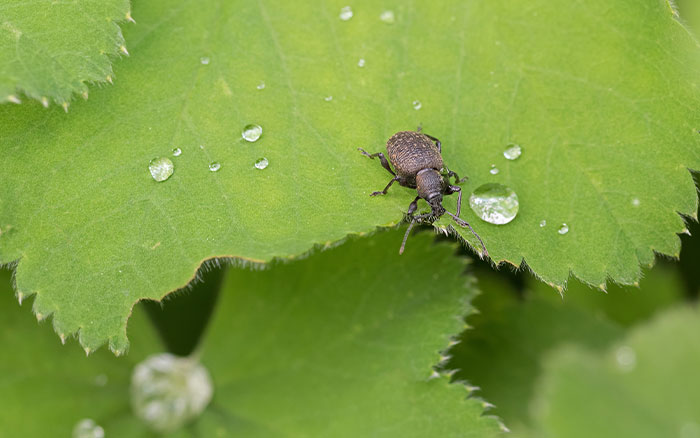Vine weevil is a night time terror in your garden, particularly the larvae on container plants. Find out how to spot, and control this pest.
Vine weevil is a flightless beetle mainly active at night. The adult eats the leaves of a wide range of ornamental plants, especially container plants. And its larvae eat plant roots.
Females lay their eggs in the soil near plants in both garden borders and plants containers. When the larvae hatch they stay in the soil, eating plant roots, which makes them a serious garden pest. They are completely indiscriminate about which plant roots they eat.
What is vine weevil?
Otiorhynchus sulcatus is a slow-moving, long-nosed, dark colour beetle, with a matt coat. They are around 1cm long, with antennae shaped in an elbow formation. Although it feeds on ornamental plant leaves, this causes relatively little harm to the plant. Unlike the larvae which can kill plants very quickly by feeding on and biting through the plant’s roots.
The larvae are white with light brown heads, curled in a ‘c’ shape and are about 1cm long.
How to spot vine weevil
Evidence of the presence of the adult beetle can be found year-round.
Larvae tend to appear between May and June. However, in the case of indoor house and greenhouse plants, they can be found between March and April. And most plant losses occur from March to September

The adult beetle
Although it is slow-moving, it is not usually active until night, making it difficult to spot. Although you can, if you feel so inclined, search for it at night with a torch!
An easier option is to look for telltale signs that it has been feeding on plant leaves. This is fairly easy to spot as the beetle leaves behind a distinctive, notch in the leaf edge. These are clearly visible on many thick-leaved, evergreen plants such as Rhododendron, Hydrangea and Euonymus.
This will alert you to the fact that the larvae may be present nearby or in containers.
The larvae
Look for the presence of the distinctive larvae in the soil surrounding plants that are either wilting and/or have leaves start to turn yellow. Also. If they’re not growing as well as expected, especially so in pot-grown plants.
If larvae are present the soil tends to be looser than expected. Careful examination of the plant may reveal the larvae in, around, and on the plant’s roots. Large sections of roots may have come away, or fallen when lifting the plant from the soil.

How to control vine weevil
The most important thing is to control the larvae as opposed to the adult beetle. As it is the larvae that kill the plant, not the adult.
Although chemical controls are available, these kill beneficial insects and natural predators of the vine weevil larvae in the process. Always use biological controls, such as nematode worms, which are available to buy online and from Garden Centres and Nurseries.

Larvae tend to be frequently found in pot plants. Particularly those that have been in pots for a long time with unchanged compost. Check plant pots weekly for signs of plants looking less than healthy. If discovered, remove all the soil and place it in a green waste recycling bin. Don’t put this in your garden compost as there may be more eggs in the compost.
It may be possible to save the damaged plant by washing all soil away from the roots still attached. Check the cleaned roots carefully to see if any larvae are wedged in between them. And then replant in another clean pot with fresh compost. Do not be tempted to re-use the same pot without first having thoroughly cleaned it out with boiling water.
If you need specialist advice, I would recommend you get in touch with your local garden centre or plant nursery.

Leave A Comment